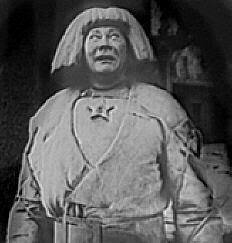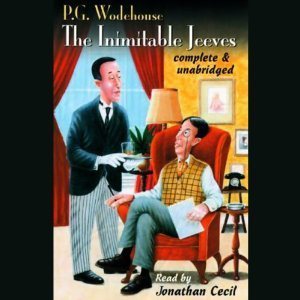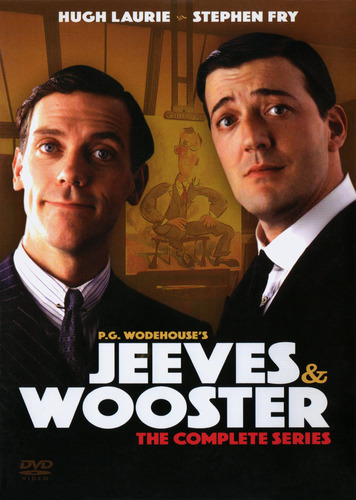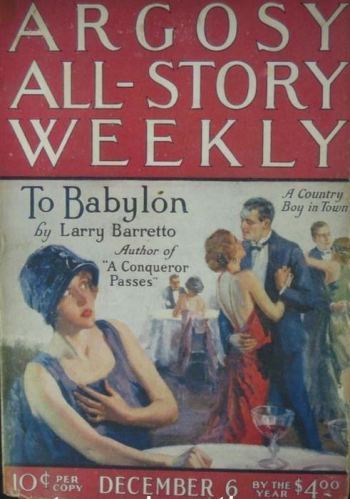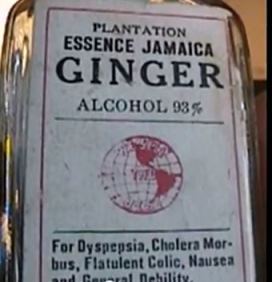Vicky Loebel's Blog, page 4
June 12, 2014
1920s References in Speakeasy Dead: The Golem
One of the things I knew when I wrote Speakeasy Dead was that my male lead, Bernie, was going to have a golem housekeeper named Gladys.
What’s a golem [goh-lum], you ask? Dictionary.com says: Jewish Folklore. a figure artificially constructed in the form of a human being and endowed with life. One story (there are many) is that a medieval Rabi, wanting to defend his hood in Prague, made a clay giant and gave it life. Things went well for a while until the Rabi and golem developed different opinions on what to smash.

Image from Wikimedia Commons
Golems were famous in silent movies. First came The Golem: How He Came into the World, a 1920 German film, following the basic text. There’s a nice print on YouTube:
In 1927, Golems returned in somewhat altered form in Fritz Lang’s famous German classic, Metropolis.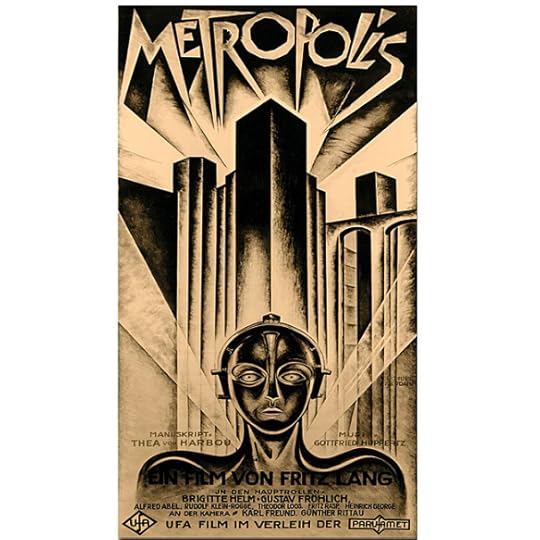 So golems were hep in the roaring twenties, but there’s another reason Gladys entered Speakeasy Dead. I wanted to pay homage to Terry Pratchett’s Going Postal. It has a subplot where golems have formed a trust to buy themselves, and one, Gladys, becomes hilariously transgendered.
So golems were hep in the roaring twenties, but there’s another reason Gladys entered Speakeasy Dead. I wanted to pay homage to Terry Pratchett’s Going Postal. It has a subplot where golems have formed a trust to buy themselves, and one, Gladys, becomes hilariously transgendered.
It’s a wonderful book. Seriously. If you haven’t read it, go grab a copy or, better, the audiobook read by Stephen Briggs. The book stands separate from the main Discworld series, so you don’t have to read them all. (Although, who can resist?)

Available in Libraries Everywhere
The last reason for (my) Gladys was P.G. Wodehouse’s Jeeves and Wooster. Right from the start, Bernie was shamelessly modeled on Bertie Wooster. Wooster has J. Therefore Bernie required G.
Many of Wodehouse’s Jeeves of Wooster books are out of copyright and can be had for free, although I highly recommend the audio versions read by Jonathan Cecil, another brilliant narrator. (Audible doesn’t have Cecil reading the first one, but some libraries do.)
The Jeeves and Wooster books are snappy, witty, and highly worth a read. In a stroke of good fortune, the BBC did a TV show that’s almost as good some years ago, starring a very young Hugh Laurie and Stephen Fry. Annoyingly, you can’t stream the TV show. But it’s worth $29.99 to own the DVDs.
Jeeves is, of course, the archetypal gentleman’s gentleman, who under no circumstances lets standards drop. Gladys, being ancient, is more progressive. She’s learned to enjoy new fashions and pounce on her weekly Argosy.
Our hero, Bernard Benjamin, claims to despise excitement. He asks for nothing but to spend his evenings playing the ukulele with college chums. Gladys enjoys a bit of adventure from time to time.
Of course, as a loyal family retainer, she’ll never go against her master’s wishes. Unless adventure happens to glide their way….


May 25, 2014
Sunday Matinee
Memorial Day weekend is here, and for those of us who haven’t loaded our Nash touring cars to head to the mountains, an afternoon at the movies seems in order. Fortunately, the Boise Egyptian Theater is within virtual driving distance.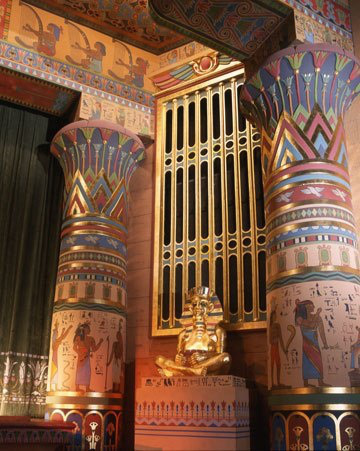
This theater opened on April 19, 1927 with John Barrymore’s 1926 film Don Juan which was, according to Wikipedia, “the first feature-length film with synchronized Vitaphone sound effects and musical soundtrack, though it has no spoken dialogue.”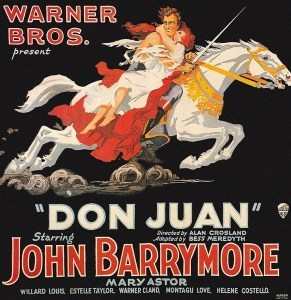
In the 1920s, it was common for theaters like the Boise Egyptian to be built with stages and to alternate vaudeville performances, lectures, and movies. Some theaters even wrote their own scores to accompany silent films, though the orchestra pit would have been empty for this Vitasound production. “Talkies,” of course, were the beginning of the end for Vaudeville.
What shall we wear for our Sunday matinée? Leslie Hindman Auctioneer strikes the right tone, I think, with this 1923 French couture dress from the collection of Katharine (McLane) Tiffany Abbott. 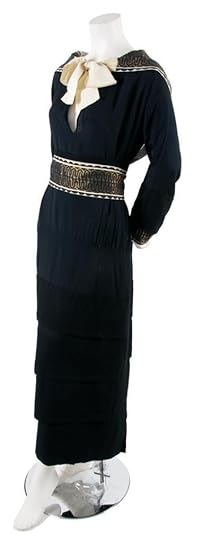
No room for a necklace with that midshipman-style bow, but we can dress the outfit up with a pair of art-deco jadeite Fouquet earrings.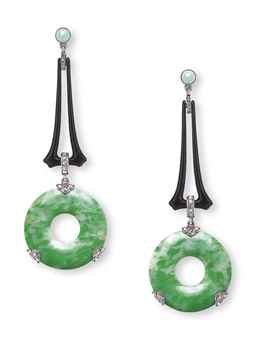 It surprised me, incidentally, to find the term “movie” dates back to 1912 – I’d expected something stodgier like “moving pictures” or “film” — but in the 1920s, movies were on the cutting edge of culture, fashion, and slang.
It surprised me, incidentally, to find the term “movie” dates back to 1912 – I’d expected something stodgier like “moving pictures” or “film” — but in the 1920s, movies were on the cutting edge of culture, fashion, and slang.
Thank goodness for the Online Etymology Dictionary!


May 18, 2014
Dress-up Sunday
Dresses are not my thing, as a rule, which is one reason I don’t lament not living in the 1920s. Nevertheless, I can occasionally see myself sipping coffee in a grand, palm-tree infested grand, with perhaps a dolphin or two frolicking in the distance. Especially in some of the sunnier 1920s styles.

For dolphin-viewing, we’ll choose the Hotel Coronado. Built in the 1880s, it was very much in vogue among the fashionable set of the 1920s.

Hotel Coronado
The Hotel Coronado is still as beautiful as ever (I’ve stayed there) though today it’s somewhat oppressed by airplane noise from the nearby naval base. This hotel was used as the faux Florida location for the (faux 1920s) film “Some Like it Hot.”
Shall we have real coffee, today? Or service from the prohibition teapot? Well…perhaps just a splash to keep off the ocean chill.


May 11, 2014
1920s References in Speakeasy Dead: Coffee

1922 (from vintageadbrowser.com)
I was planning to blog about coffee in the 1920s. It had been popular forever, sure. Laura Ingalls Wilder’s parents brewed it over their campfire. But had modern changes swept the land? How were beans roasted? Ground? Brewed? My extensive 15-minute sweep of the internet left me with a few unanswered questions.
Maxwell House was going strong in the 1920s, for example, and was delivering canned, roasted wake-up juice to a sleepy American public. But was this stuff ground or in beans? Ground, probably, but it’s hard to tell from the ads.

Maxwell House Coffee Ad Schooner “Blossom” Art (1924) (from vintageadbrowser.com)
Once the stuff was out of the cans, how was it brewed? A lot of people still boiled water and brewed coffee on their wood- or (increasingly) gas-fired stoves.
But some modern households had adopted the electric percolator, screwed (or later plugged) into those handy outlets that were created by adding wires along the surface of walls. Don’t worry kids. Most of the time, those wires were insulated.
But while the electrical wiring might be iffy by today’s standards, they knew how to serve and drink coffee in style.

Eric Magnussen, 1927


April 7, 2014
Featured Read: Tara Maya’s “Unfinished Song”
I’ve been reading a lot of roaring twenties books, this last year, either nonfiction written about the 1920s, or books published in the 1920s.
Most the new fiction I’ve come across and enjoyed has been the result of meeting other indie writers, and one such happy accident was the discovery of Tara Maya and her six-volume Young Adult Fantasy series “Unfinished Song” which I’ve been finding greatly enjoyable.
Unfinished Song: Book 1, Initiate is the coming-of-age story of Dindi, a girl who wants to develop her talent as a magical dancer. The problem is, she comes from a family that has not only never passed the initiation ritual, but has died trying. From that premise, Tara Maya weaves a delicious combination of traditional magic elements, cross-cultural myths, and strongly grounded, believable characters that manages to hit all the fantasy buttons and still feel engaging and fresh. My only slight reservaton was that the characters were a bit self-absorbed for my taste, but that is a hallmark of Young Adult literature and fits perfectly with the genre.
I’m featuring Unfinished Song #1 here today, complete with excerpt & beautiful cover art. The first book in the series is available FREE, so if you or a young person in your life might be interested, click one of the links at the bottom and give it a try!
THE UNFINISHED SONG (Book 1): INITIATE by Tara Maya
(scroll down to read an excerpt)
DEADLY INITIATION
A DETERMINED GIRL…
Dindi can’t do anything right, maybe because she spends more time dancing with pixies than doing her chores. Her clan hopes to marry her off and settle her down, but she dreams of becoming a Tavaedi, one of the powerful warrior-dancers whose secret magics are revealed only to those who pass a mysterious Test during the Initiation ceremony. The problem? No-one in Dindi’s clan has ever passed the Test. Her grandmother died trying. But Dindi has a plan.
AN EXILED WARRIOR…
Kavio is the most powerful warrior-dancer in Faearth, but when he is exiled from the tribehold for a crime he didn’t commit, he decides to shed his old life. If roving cannibals and hexers don’t kill him first, this is his chance to escape the shadow of his father’s wars and his mother’s curse. But when he rescues a young Initiate girl, he finds himself drawn into as deadly a plot as any he left behind. He must decide whether to walk away or fight for her… assuming she would even accept the help of an exile.
EXCERPT
Blue-skinned rusalki grappled Dindi under the churning surface of the river. She could feel their claws dig into her arms. Their riverweed-like hair entangled her legs when she tried to kick back to the surface. She only managed to gulp a few breaths of air before they pulled her under again.
She hadn’t appreciated how fast and deep the river was. On her second gasp for air, she saw that the current was already dragging her out of sight of the screaming girls on the bank. A whirlpool of froth and fae roiled between two large rocks in the middle of the river. The rusalka and her sisters tugged Dindi toward it. Other water fae joined the rusalki. Long snouted pookas, turtle-like kappas and hairy-armed gwyllions all swam around her, leading her to the whirlpool, where even more fae swirled in the whitewater.
“Join our circle, Dindi!” the fae voices gurgled under the water. “Dance with us forever!”
“No!” She kicked and swam and stole another gasp for air before they snagged her again. There were so many of them now, all pulling her down, all singing to the tune of the rushing river. She tried to shout, “Dispel!” but swallowed water instead. Her head hit a rock, disorienting her. She sank, this time sure she wouldn’t be coming up again.
“Dispel!” It was a man’s voice.
Strong arms encircled her and lifted her until her arms and head broke the surface. Her rescuer swam with her toward the shore. He overpowered the current, he shrugged aside the hands of the water faeries stroking his hair and arms. When he reached the shallows, he scooped Dindi into his arms and carried her the rest of the way to the grassy bank. He set her down gently.
She coughed out some water while he supported her back.
“Better?” he asked.
She nodded. He was young–only a few years older than she. The aura of confidence and competence he radiated made him seem older. Without knowing quite why, she was certain he was a Tavaedi.
“Good.” He had a gorgeous smile. A wisp of his dark bangs dangled over one eye. He brushed his dripping hair back over his head.
Dindi’s hand touched skin–he was not wearing any shirt. Both of them were sopping wet. On him, that meant trickles of water coursed over a bedrock of muscle. As for her, the thin white wrap clung transparently to her body like a wet leaf. She blushed.
“It might have been easier to swim if you had let go of that,” he teased. He touched her hand, which was closed around something. “What were you holding onto so tightly that it mattered more than drowning?”
LINKS
Tara’s blog http://bit.ly/MtlSRJ
Tara’s Twitter http://bit.ly/162sCtE
The Unfinished Song on Facebook http://on.fb.me/1400mMq
Amazon http://amzn.to/15ciwYc
Barnes and Noble http://bit.ly/13yM5Dr
Kobo http://bit.ly/1aFhg1P
iTunes http://bit.ly/1baddhN
Smashwords http://bit.ly/17zK8Xn
Initiate is free everywhere except on Barnes and Noble (where it’s $0.99). You can download a free .epub version via Smashwords.


April 3, 2014
I Take It Back
April 1, 2014
Tennis, Anyone?
OK this isn’t a 1920s tennis dress by any means, but possibly something that might have been worn to watch a tennis match?

1920s Dress Restoration: The Vintage Traveler
Whatever the purpose, it’s absolutely marvelous. Not only does it have the super-cute art-deco sports design, but the orange color (known as Tango and associated with the dance) was the height of fashion for much of the 1920s. Dresses, walls, paint, furniture, jewelry, pretty much everything but cars could be found in Tango orange.

1920s Tango-Orange Celluloid Pendant with Hidden Comb
I came across this dress on The Vintage Traveler which is a blog written by a clothing collector and seamstress of vastly greater expertise than myself. She discovered the dress after it had been altered by the addition of a zipper and darts (definitely not 20s!) and decided to restore it. You can read her interesting posts about the reconstruction here:
1920s Deco Dress with Sports Motif, Part 1
1920s Deco Dress with Sports Motif, Part 2
Thanks to The Vintage Traveler for sharing this project!


March 28, 2014
1920s References in Speakeasy Dead: The Breakfast Nook
The 1920s housewife faced a dilemma. Eating in the dining room was a lot of trouble, especially as she was unlikely to have domestic help beyond, perhaps, someone to do the wash. One could have an eat-in kitchen, of course. The 1920s house I grew up in was set up that way. My grandmother’s more fashionable home, on the other hand, included a breakfast nook.

1920s Blabon Art linoleum Ad
Sometimes part of the kitchen, sometimes located between the kitchen and dining room, the breakfast nook personified the dual elements of cozy and stylish that were so important in 1920s homemaking. It might not always have been easy, cramming the family into those wooden benches or leaning over to wipe up spills. But who could resist a picture like this?

1921 Morgan Woodwork Organization Illustration
Strictly speaking, the breakfast nook is a 1920s reference that didn’t make it into Speakeasy Dead. One of the main characters, Bernie, lives in a very early craftsman bungalow built by his family.

House 158 from Henry Wilson’s 1910 “Bungalow Book”
I wanted Bernie to have a nook, and he and his cousin, Clara, obligingly ate breakfast together one morning across eggs Benedict and coffee. As the novel progressed, it became necessary to shift the scene to Clara’s Speakeasy, so Bernie’s breakfast nook lost its cameo.

Nooks were sometimes defined by kitchen furniture, as in this 1921 Ladies Home Journal ad for Blabon linoleum
Bernie’s nook hasn’t given up hope. There are still gangsters in Falstaff who may need to squeeze onto those benches for comedic purposes.


March 4, 2014
1920s References in Speakeasy Dead: Prohibition and Bootleg Booze
One of the operations taking place inside the Falstaff Ninepin Fellowship is the distillation of bootleg booze. This is not exactly a product of prohibition, since Clara’s half-sister, Priscilla, has been distilling apple brandy for years. But it comes into play when the elegant Hollywood Grand hotel opens across the street stimulating the demand for quality liquor.

Cognac Pot Still (source: Wikipedia)
And brother, was there demand! By 1924 much of the alcohol that had been stashed away when Prohibition went into effect (January 17, 1920), had been consumed, and a thirsty public was turning to more dangerous sources. Often this took the form of “denatured” alcohol—spirits intended for industrial use that had been deliberately poisoned by the government—which would be filtered or blended by unscrupulous bootleggers and sold as drinkable liquor. 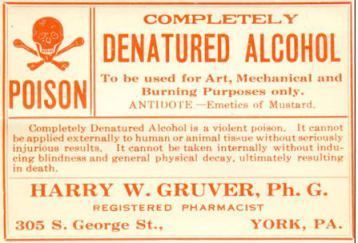 The book " target="_blank">Bobbed Hair Bandit reprints the New York Daily News “Hands of Death” summing up the statistics for 1923. Although Moonshine deaths (271) lagged far behind the number one killer of the day, cars without seatbelts (884), it beat gun-violence by one.
The book " target="_blank">Bobbed Hair Bandit reprints the New York Daily News “Hands of Death” summing up the statistics for 1923. Although Moonshine deaths (271) lagged far behind the number one killer of the day, cars without seatbelts (884), it beat gun-violence by one.

Reprinted from 1923 New York Daily News
As P.G. Wodehouse puts it in his memoir, Bring on the Girls, “People had learned to cope with [prohibition] at least to the extent of having their liquor analyzed or, in an emergency, of pouring some into a saucer in a darkened room, setting fire to it, and, if it burned with a reddish flame, changing their bootlegger.”

This 1920s scientist bears a faint resemblance to P. G. Wodehouse
One of the most infamous cases of alcohol poisoning came from the patent medicine known as “Jake” made from an extract of Jamaica ginger. Jake itself was not dangerous, but when a pair of amateur chemists developed an additive intended to trick regulators, they accidentally laced the popular concoction with neurotoxin.
Tens of thousands of Americans (some say up to 100,000) suffered varying degrees of paralysis of their lower limbs, and the permanent flopping “Jake-walk” that resulted was the subject of several blues songs like Asa Martin’s 1933 Jake Walk Papa.
In Speakeasy Dead, Priscilla Woodsen is an expert alchemist and poses no threat to the community. Unfortunately, some very unsavory gangsters may pose a threat to the coven.
References:
The Jake-Leg Infamy (indie documentary on YouTube)

The Bobbed Hair Bandit by Stephen Duncombe and Andrew Mattson

Bring on the Girls by P. G. Wodehouse & Guy Bolton

Last Call: The Rise and Fall of Prohibition by Daniel Okrent


February 25, 2014
Maxim’s, Anybody?
I feel like eating out today. Who’d like to join me at Maxim’s?

Studio Henri Manuel, Paris, 1929
According to Wikipedia, this restaurant has been a go-to eatery for the well-heeled since 1893 & currently belongs to Pierre Cardin.
Jean Cocteau is quoted as saying in 1913: “It was an accumulation of velvet, lace, ribbons, diamonds and what all else I couldn’t describe. To undress one of these women is like an outing that calls for three weeks’ advance notice”
Of course, by 1929 the world was speeding up considerably. You could have stripped most flappers in sixty seconds flat.

Maxim’s Paris
It was the men who still insisted on wearing hat, coat, detachable collar, tie, vest, braces, cufflinks, a long-sleeved shirt and undershirt, etc….
[image error]
Charlie Chaplin 1922. A natty dresser when he wasn’t acting the “Tramp”
.



